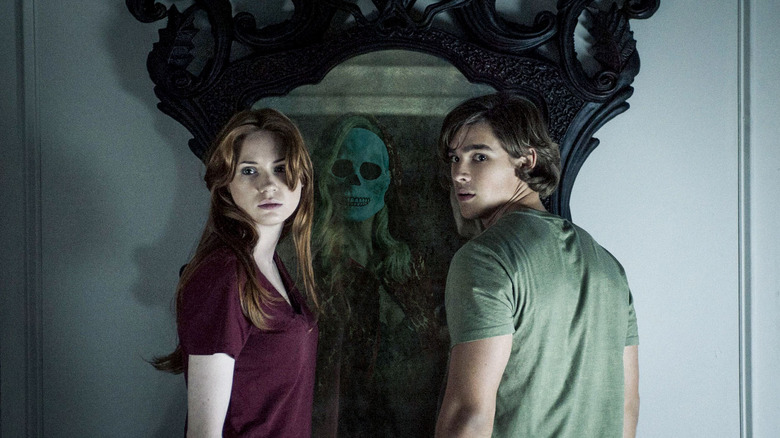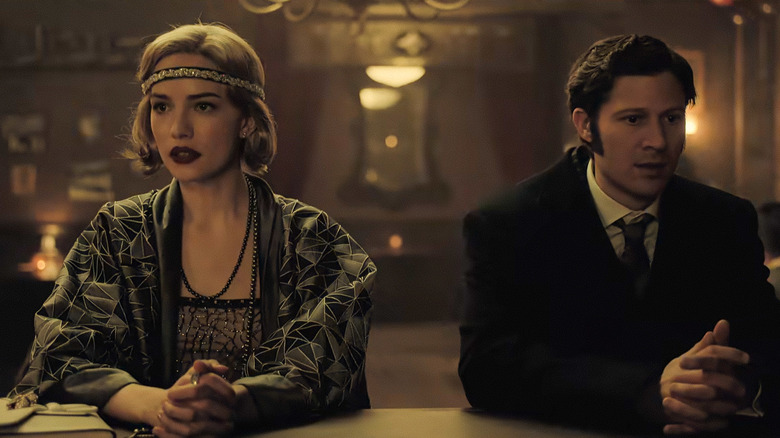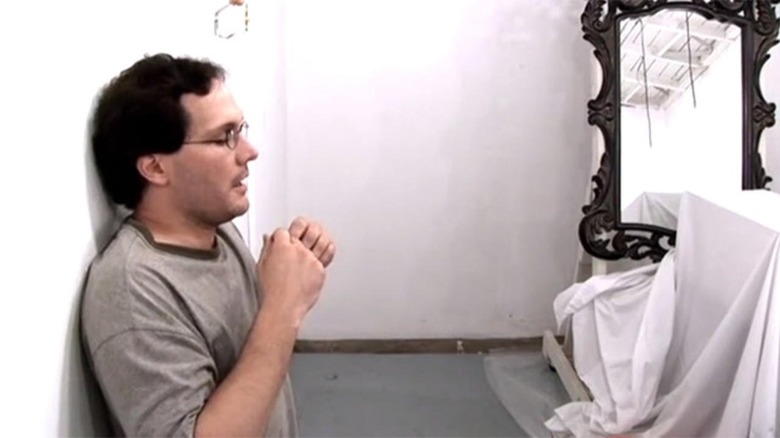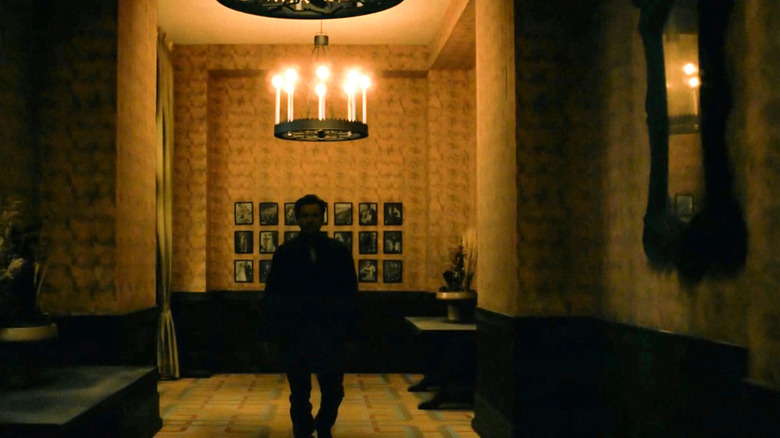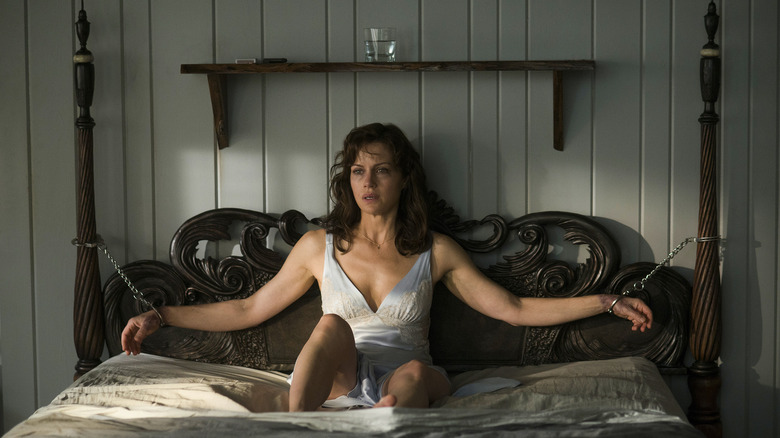The Evil Mirror From Oculus Has A Cameo In The Fall Of The House Of Usher
Sure as the Pizza Planet truck will show up in every Pixar movie (except "The Incredibles" for some reason), the Lasser Glass can always be found somewhere in Mike Flanagan's horror movies and TV shows (except "Hush" and "Before I Wake," for some reason). This ornate, evil mirror hails from the very beginning of Flanagan's career — a short film called "Oculus: Chapter 3 – The Man with the Plan," made in 2005 — and the filmmaker has brought it with him ever since. Either that ... or it's been following him.
As you might expect, the Lasser Glass makes another appearance in Flanagan's new Netflix series, "The Fall of the House of Usher." An adaptation of various works by Edgar Allan Poe, the eight-episode series reimagines the doomed Usher family as pharmaceutical magnates in the vein of the real-life Sackler family. The Ushers have played a major role in creating America's opioid crisis, but have escaped justice thanks to a Faustian bargain made many years ago. As Roderick Usher approaches the end of his life, something has come to collect on the deal — and his children must pay the price.
Where there are spooky goings-on and people meeting with nasty fates, the Lasser Glass is sure to be found. Here's where you can spot it in "The Fall of the House of Usher," and throughout the rest of Flanagan's works.
Vino, veritas, Verna
That pesky "Oculus" mirror can sometimes be hard to spot — out of focus or hidden in the background. Such is the case in "Fall of the House of Usher," where it can be found in the back of Verna's bar in flashbacks to a certain fateful New Year's Ever. When Roderick and Madeline sit down at the bar, look between them and you'll see the Lasser Glass, quietly working its malevolent magic. Keep an eye out for it around the 46-minute mark in episode 1, "A Midnight Dreary."
Without giving too much away, it's eventually revealed that this bar isn't entirely a natural place — which makes it the perfect place to hang the mirror. Flanagan's original short film explained that the origins of the cursed object are unknown, but it first appeared in the possession of a man called Philip Lasser in 1754, which is where it got its name. Sometime after hanging the mirror over his fireplace, Lasser was found burned to a crisp in the fireplace.
Since then, the mirror has changed hands hundreds of times, leaving a bloody trail in its wake. Some people simply waste away in front of it, as though it stole their life force ("lasser" is a French verb, meaning to make weary). Others were seemingly driven mad by it, killing their loved ones and mutilating their own bodies.
It's not exactly the kind of mirror that set decorators can just casually hang up in a bedroom or dining room without spoiling some of its mystique. So, if you're searching for cameo appearances in Flanagan's works, keep your eyes peeled during scenes set in the creepiest places: attics, basements, and abandoned hotels ...
Oculus: Origin of Evil
Though most horror fans will know the Lasser Glass from Flanagan's 2013 feature film "Oculus," the filmmaker first brought the concept to the screen several years earlier. "Oculus: Chapter 3 – The Man with the Plan" starred actor Scott Graham as the titular man with a plan: a man who has been obsessed with the mirror ever since it killed his parents, and is determined to catch it doing haunted stuff on camera. As Flanagan explained to Complex, the limited budget meant that the fabled Lasser Glass was actually just a plastic mirror — the since-discontinued Monte Paraiso mirror, from the Howard Elliott Collection — that had been bought online.
As for why the short was called "Chapter 3"...
"Initially, we wanted to do an anthology with the mirror concept. We wrote nine short stories about the mirror; the one we shot was the third one, which was the most contained and easiest to produce, and because it had the element of the mirror's history. We always wanted to go back and do more, but there was no money and no time. A short film doesn't have any really viable distribution outlet, so you can't make your money back. The best you can do is put it out there, get some buzz, and hope it can lead to something else. When it came down to it, if I was going to beg for money and scrape whatever I could together for an indie production, it had to be a feature."
Sure enough, the short film got studios' attention and Flanagan was eventually able to make the full-length feature film, starring Karen Gillan and Brenton Thwaites as siblings who decide to confront the mirror that killed their parents when they were children.
The Lasser glass through the ages
The Lasser Glass that appears in "Oculus" and has cameo roles throughout the rest of Mike Flanagan's oeuvre is not the original plastic mirror that appeared in the short film. As Flanagan explained to MoviesOnline, the modest $5 million budget for the feature allowed the creative team to commission a unique design, "taking some DNA from that original mirror but trying to come up with something that was going to be even more impactful, more organic." The filmmaker elaborated:
"There's something really awesome that they did with the mirror which is when you get really close to it, the frame itself is comprised of these writhing humanoid forms that are all interlocked. You can't really see it from a few feet away. You have to get right up against it to really pick up that detail, which I loved ... [We had] the idea that this was an organic creature that was digesting the souls of the people that it would come in contact with."
A prop like that is too good to use just once. Here are all the Lasser Glass cameos in Flanagan's works so far:
- "Ouija: Origin of Evil" – In the basement at around the 1:07:05 mark in the movie.
- "The Haunting of Hill House" — Hanging up behind the creepy statues on the ground floor. It can be seen at around the 37:25 mark in episode 1.
- "Doctor Sleep" — On a wall in the Overlook Hotel (see above). Danny walks past it at around the 2-hour point in the movie's runtime.
- "The Haunting of Bly Manor" – In the attic. Look behind Dani when she's tied up at the start of episode 7, "The Two Faces, Part Two."
- "Midnight Mass" — Lurking under a sheet on the stage in the rec center during AA meetings. You can spot it in episode 3, in a scene that begins about 9 minutes in.
- "The Midnight Club" — Among the junk in the basement. Visible in episode 6, "Witch," at the 46:07 mark.
Sneakier Lasser Glass cameos
Not every story presents an opportunity to have a conspicuously ornate mirror hanging out in the background, so Flanagan has found other ways to incorporate it into his stories. The most notable example of this is "Gerald's Game," his film adaptation of the novel by Stephen King, which is set almost entirely in one room. Carla Gugino (one of Flanagan's regular collaborators, who also plays Verna in "The Fall of the House of Usher") plays a woman called Jessie who finds herself in a horrifying survival situation when her husband dies of a heart attack after handcuffing her to a bed for some sexy roleplay.
Here, the Lasser Glass doesn't have a blink-and-you'll-miss-it cameo; it's practically a main character. Flanagan confirmed in an interview with Den of Geek that the headboard of the bed that Jessie is handcuffed to is based on the bottom edge of the "Oculus" mirror's frame. Both the mirror and the headboard were designed by sculptor and special effects artist Bruce Larsen.
Similar, though not identical, design elements can be seen in the carved backs of Roderick Usher's dining room chairs in the opening episode of "The Fall of the House of Usher" — perhaps foreshadowing the fact that most of the people at the table will end up dead (that's not a spoiler, by the way; the series opens with a group funeral for the Usher children). And in the case of one member of the Usher family, a mirror is actually the cause of their demise. Lesson learned: don't trust mirrors.
